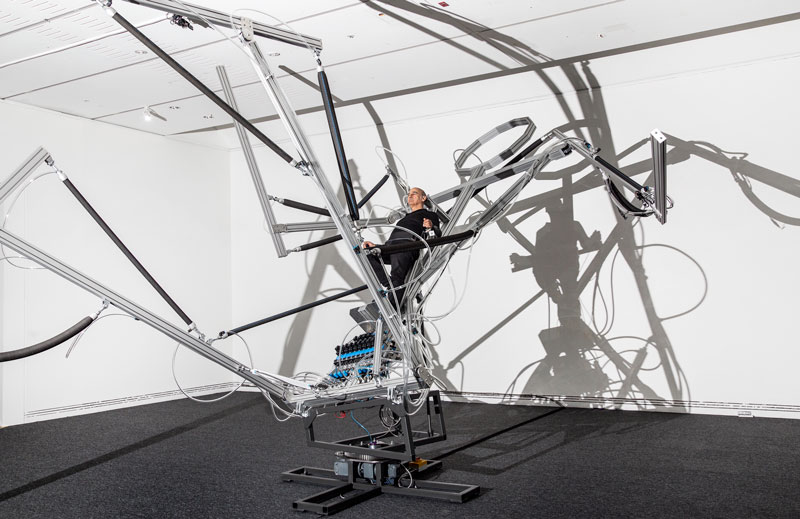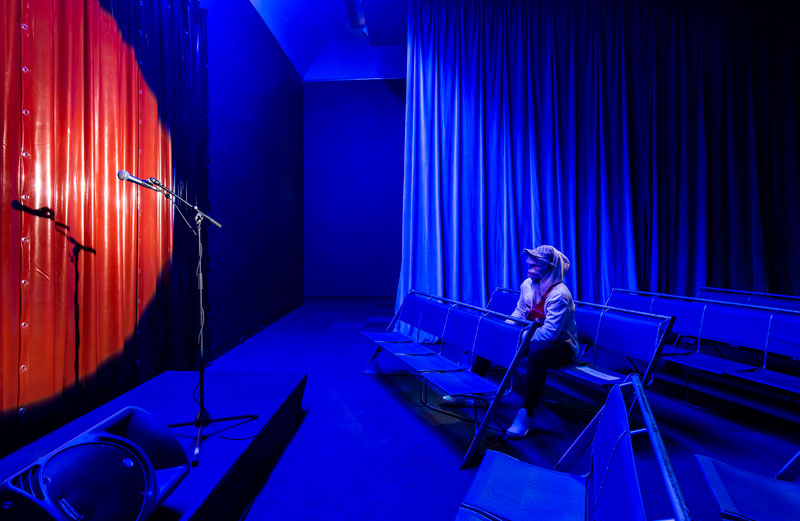
Early on Sunday 15 March I flew from Perth to Adelaide with the brief of reviewing the 2020 Adelaide Biennial, Monster Theatres, curated by the Art Gallery of South Australia’s Curator of Contemporary Art, Leigh Robb. The Federal Government had less than 48 hours before – on the auspicious date of Friday 13 March – announced a ban on gatherings of over 500 people, one in a series of that days’ dramatic breaking news alerts that escalated simmering national anxiety about COVID-19 into a full-boil rolling crisis. By the time I flew home on Monday evening, my office had issued a directive that we would be working remotely, indefinitely. Art galleries, in step with all other cultural institutions around the nation, were cancelling public programs or closing entirely. It was clear then that the trip I’d taken was likely irresponsible, and that the Biennial’s days were numbered. A short way into the fourteen days of my self-isolation the Art Gallery of South Australia and several of the Biennial’s satellite locations in Adelaide’s Botanic Gardens shut their doors, just over two weeks after the exhibition had first opened to the public. Under these circumstances it has been difficult to think of anything approaching the normal format for a critical review.
Sometime in late January I had called Leigh Robb at AGSA to talk about a different matter, and she had mentioned then that artists exhibiting in the Biennial were meditating on the year’s initial unprecedented crisis, the bushfires that swept through large parts of the country, including the Adelaide Hills and on Kangaroo Island. The crisis loomed large for a cohort deeply concerned with climate change and the Anthropocene, and larger still for another cohort grieving direct impact on their families or on Country. Robb, in January, found herself already negotiating between reaction and reflection, grappling with an intense media interest in these potential artistic responses, with responsibilities to individuals and communities still too immersed in mourning to experience their tragedy as representation, with the rub between an understandable desire to remain creatively agile and a museum framework that observes strict environmental, security and bureaucratic standards.
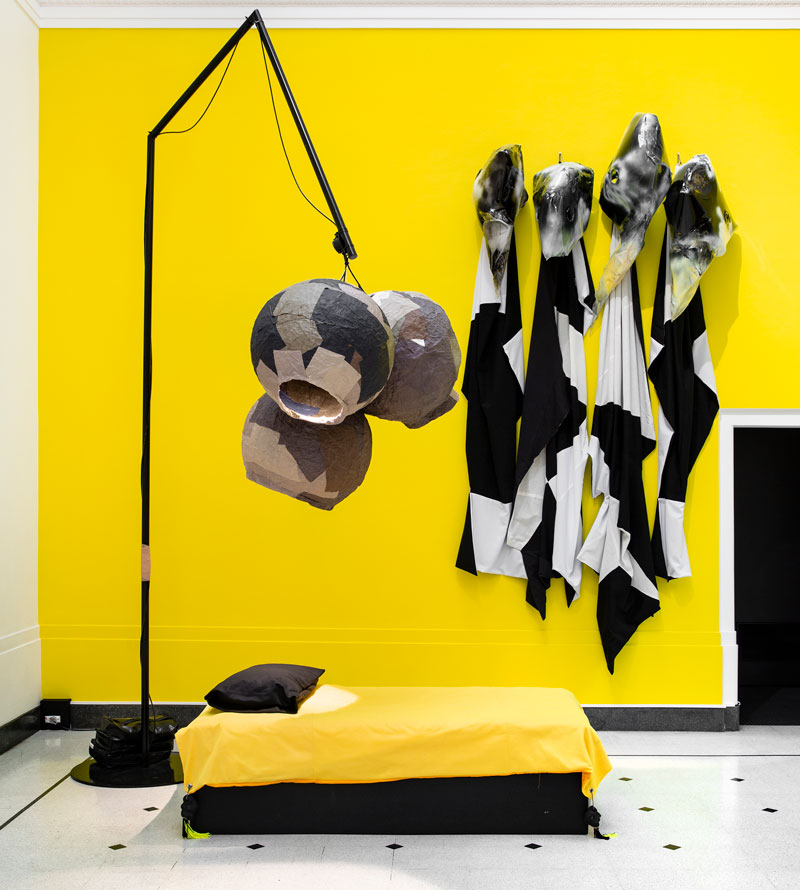
Now, opening across what will come to be known as a dividing line of history, the exhibition finds itself again at the mercy of a context its artists or its curator could hardly have anticipated. Viewing it on the transitional cusp of the crisis, my experience of many works was already profoundly shifted by their new reality. The most explicit of these is an installation by Mikala Dwyer that festoons the opening of the Art Gallery of South Australia with banners and flags that signal biological hazard, with an installation in the vestibule of two “sick bays” in bright, toxic yellows and shiny blacks. Beaked and hooded gowns, like the plague masks of yore, are hung at the ready. This grim proximity of reality and representation is of course retroactive; neither Dwyer nor Robb could have anticipated the field hospitals erected in Central Park in New York, a navy hospital ship painted entirely white but for the red crosses; so surreal and somehow ghastly beautiful, gliding into the city’s harbour. And, while the virus had been active in China for some months before the exhibition opened, it is hard to not to view these works as a grim premonition.
This shift is echoed in other works less literally concerned with human frailty. Abdul Abdullah’s prolifically Instagrammed installation Understudy places a human-scale Yunnan monkey in high fashion streetwear in a theatre as empty as any any around the nation. David Noonan’s meditative A Dark and Quiet Place fades in an out of elegant imagery of theatrical scenes stylised by excision. They are anxious and sparse, the figures held within them atomised and separate. Throughout the exhibition the human body is subjected to violence originating both from within and without. The Biennial spills out of the temporary galleries and into AGSA’s permanent collection, where Mike Parr is shown (originally live, but now on a monitor) – like we all are now – in A Reading for the End of Time. And Kynan Tan’s computer simulations attempt to learn how to work like humans in industries already disrupted by automation and distance – drone strikes, delivery warehouses, ridesharing. Computer-generated machines wobble clumsily in landscapes in which human presence is limited. When I visited this generative AI work, the rideshare algorithm had driven its car into a partition and remained trapped, unable to learn its way around it. It had completed zero trips. This three-channel animation is positioned in the collection gallery otherwise devoted to representations of death.
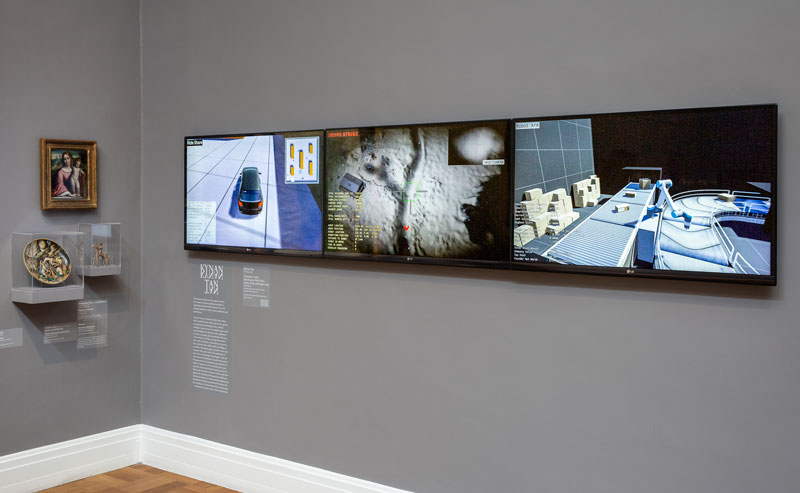
Monster Theatres spins both of its key words in varying directions, but all lead from the body or its absence. On the Monday I spent at the gallery and in the gardens the public was already self-regulating in response to government directives and AGSA’s visitor numbers had dropped from 3,500 per day to just 350. In quiet rooms figures loomed from spot-lit darkness: my dominant memory is of being in a wax museum. If the exhibition seeks a coherent position on monstrosity it that it is intersectional, dependant on the dynamics of class, race, gender, sexuality and ability that are activated when one human gazes upon another. Robb notes that the root of the word monstrare means “warning”, but warnings that play on fear can be slippery, wielded to maintain power. Jacques Callot’s 1635 etching, the Temptation of St Anthony, included in a companion exhibition of historical prints, shows the saint tormented by a horde of creatures engaging in what might be described as sodomy or anal play, depending on your perspective. “Monstrosity” is, in this case, a literal demonisation of sexual deviance.
The colonist also evokes black monsters while perpetrating monstrous acts. Noongar author Claire G. Coleman puts this in stark terms in her text for the catalogue, also manifested in the poignant “Dickensian” brutality of installations by Karla Dickens, who presents a kaleidoscopic carnival of white cruelty at AGSA and Yhonnie Scarce’s organ-like glass forms viewed through windows into the “Dead House” at Adelaide’s Botanic Gardens, a former mortuary presided over by a physician known for collecting Aboriginal remains. Coleman writes: “I am blak, I am woman, I am queer, I am what you fear (when you are more dangerous to me/Than I could ever be to you).”
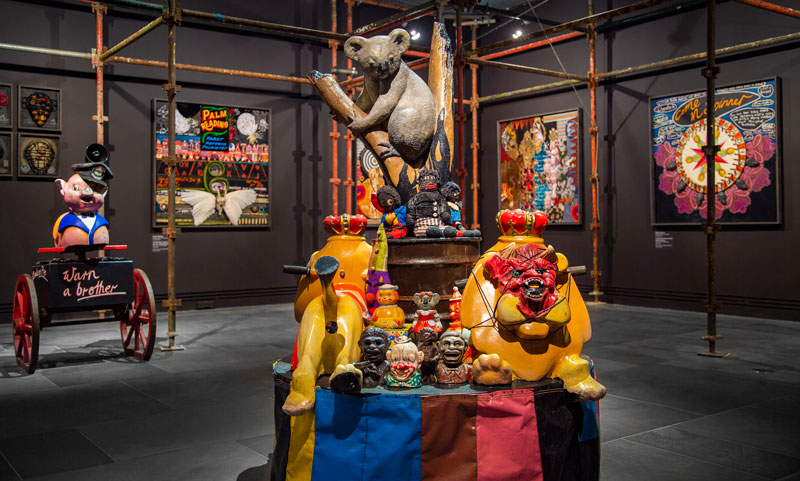
Monster Theatres aims to subvert the spectacles of human difference produced by the powerful – like the grotesquely popular “freak show” of the Victorian era, which regularly pillaged the colonies for exotic human exhibits – into a plea for empathy and connection. In revealing the monster as an entirely cultural construction, we might learn to transcend our worst selves, work through our fears and be alive to our prejudices. The exhibition’s key moments of redemption, implacable in relation to monstrosity, refer to connection and collectivity. For example, Julian Day makes history through the harmony of breath, charting the influence of German migration to South Australia through an assemblage of elegant documentary footage of choirs placed in dialogue with a deconstructed pipe organ, supported by the performances on the opening weekend in Adelaide’s Masonic Lodge on North Terrace. In a cabin in the Botanic Gardens Mike Bianco offers ritual solace and healing through the vibrations of a beehive-turned bed.
But what to do with collective connection now, when gathering for protest is illegal, without the aliveness of touch? What to think of the spectacularly monstrous from within a crisis characterised by invisibility and absence? In her Director’s Foreword to the catalogue, Rhana Devenport opens by stating that the “magic of any recurring art exhibition is that it represents the zeitgeist of art and ideas that belong to a moment in time: focused, curated and located.” But calendar years have become like dog years compared to timeframes for artistic development. For the privileged, myself among them, it has been a significant lesson to confront what changes can be wrought to the social order in just three months, or in just two weeks.
When I call Leigh Robb again, from isolation, she is in a reflective mood. She has spent her week, as many of us have, trying to reverse-engineer something designed for embodied viewing into a long-distance experience. Again, we are trapped in the battleground between agility and pause. She says of the Biennial, likely to be extended past its original 8 June end date but locked in place anyway by social distancing requirements: “It’s like I’m presiding over a time capsule.” I tell her that just that morning I had heard a segment on RN Breakfast supposedly about the value of the arts in times of crisis that used two home-made “viral” parody videos made by families in their homes as proof of concept. No one knows yet what culture will look like on the other side of this.
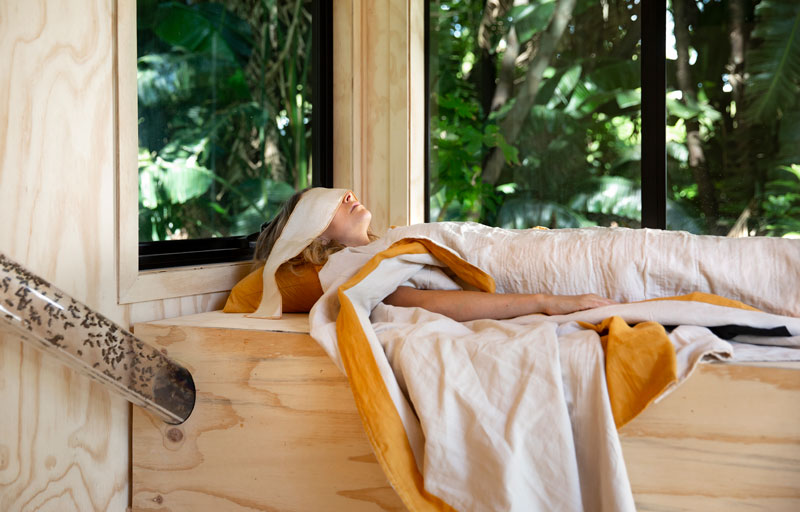
Robb says, “It’s there in the name, contemporary art – “Con tempo” means “together with time” … We want and have come to expect this from art named thus, that it is defined by a self-conscious reflection of the now. The implication is that its currency will be the source of its value, a flirtation with the immediate redundancy that comes with hyper-relevance. The implication is that the more easily legible politics as content become superior to the politics of form. I joke about the irony of the exhibition’s weird prescience against definition-shifts in curatorial practice over the last fifty years towards trend-forecasting, identifying not just what’s now, but what’s next. And we joke – because what else can be done – about the grief we both feel, that artists everywhere are feeling, because that’s what it is to have laboured and lived with something so long that’s now gone. Grief. We’re mourning. She says, “Of all the phases of grief the one I’m stuck in is bargaining, trying to revise it, to keep it alive – a kind of Frankenstein’s monster – for the artists and for myself. But I also have to move straight to making meaning.” There isn’t time.
She tells me that there are unforeseen consequences that keep playing out as metaphors. Stelarc’s original plan for his 9-metre robot Reclining StickMan was to have it functional 24 hours per day. The sculpture, a mechanical exosketeton, referencing the most basic of bodily representations flails in slow-motion through a series of movements that can be choreographed by inputs from a touch pad, by the artist strapped into the armature or remotely online. Security limitations around the gallery’s opening hours meant that 24-hr operations had to be sacrificed due to practical logistics. But now that the gallery is closed to the public, the Reclining Stickman can function as intended. The monster remains, alive in the basement. The curious public can communicate with it – like they are communicating with everyone – from behind the safe distance of a digital screen.
I can’t decide whether Stelarc’s favourite provocation is perfectly redundant, or perfectly real but it makes me, like everything these days, weep:
THE BODY IS OBSOLETE.
